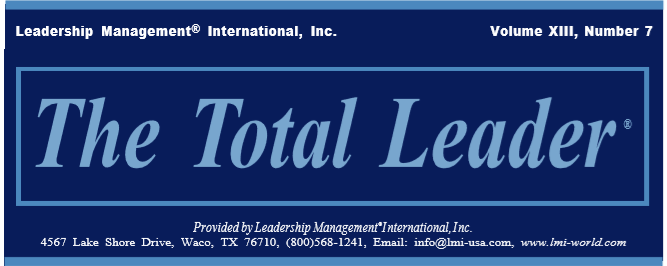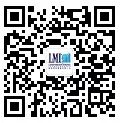——关注LMI中国,更多精彩分享——

LMI-WORLDNEWSLETTER 7-1
——个人成功——
推倒障碍,提升团队

“聆听的障碍存在于环境、态度和行为层面。意识到障碍有助于你采取适当的行动来开放沟通之门。”

任何损害聆听的事物都会成为障碍,妨碍理解、关闭通往沟通的终极目标之门——产生建设性行动。
聆听的障碍存在于环境、态度和行为层面。意识到障碍有助于你采取适当的行动来开放沟通之门。
物理性障碍
环境障碍最容易克服。你可以关门来减少让人分心的噪音。你可以安排在不受打扰的时间沟通,也可以在一个重要沟通活动前安排舒适的物理环境。
最难克服的物理性障碍或许是人类思维的速度。人们平均的沟通速度大致为每分钟125个字——如果信息复杂,则更少一些。但你的思考速度可以达到每分钟400-600字。听者大脑往往更放松,因此,听者的思维会走神而不能抓住所表达的信息。大脑处理信息的速度在专心和注意力方面呈现显著的物理性障碍。
有两个卓越的工具有助于克服这一物理性障碍并聚焦大脑处理能力:
组织:每一位能同时处理一项以上基本任务的人,都习惯于组织行为、想法和目的。此项技能也可以运用于聆听。当你聆听时,可以用大脑组织听到的内容。跟随说话人的逻辑,如果能帮你专心就做些笔记。
分析:当你倾听时,分析你听到的想法。将其与你已知的信息进行比较;寻找因果之间的逻辑关系。
态度式障碍
阻碍沟通的态度很容易被发现,但有时并不显现。有时,可能只需要看一眼就能发现有些人只是假装在听、或者他们并非真正关注该主题,与此相反,有些人事实上早已打定主意而不再接受新想法时却装出感兴趣。其他类似的态度造成听不进他人讲话、或因为说话人的外表、声音和其他外在特质而对说话人的价值打折扣。
在沟通中一个最普遍的态度式障碍就是选择性聆听。因为我们只喜欢听见让我们愉快的、或与我们预设的计划和想法一致的内容,就很容易听不全或摒除我们发现不愉快或不同意的内容。
因为选择性聆听对关系的破坏力如此强大,务必觉察你参与的任何领域。运用一个计划来改变你的态度,从而改变你的行为。
和选择性聆听具有同样破坏力的一个态度式障碍是过度反应。判断草率、情绪失控、不当反应——尤其当它们在你未得到完整信息前就已发生时——会摧毁相互理解与合作的任何希望。
强大而安全的自我形象,以及对他人价值的信任是克服沟通中态度障碍的最佳工具。认可沟通本身重于所发送和接受的内容。探索能够加强你自尊的策略并加以实施。无论他人说、想或做什么,都下决心以尊重待人。在你所有的人际关系中表现真诚的同理心。这些承诺能够加强理解并产生建设性行为。
行为障碍
减弱沟通效力的行为包括中断聆听的语言和非语言行为。一个最常见的聆听障碍是打断说话人。当人们打断说话人时,他们的行为被看作缺乏理解、没有礼貌或拒绝接受。
其他语言类聆听障碍包括批评和试图控制。习惯性批评者阻断他人创造性想法的心流。喋喋不休的说话人和那些试图操纵或控制他人及情境的人传递出这样的信息,他们认为沟通只是单向的——从他们到其他人。他们不停地问自己或其他人:“我需要知道什么?”
障碍聆听的非语言行为往往表现在身体姿势上。瘫坐在椅子上、避免眼神接触、故意忙于其他事务、紧张不安,都在传递信息:“我没有聆听,你无法打动我。”

有效聆听
有效聆听是主动的、而非被动的。聆听需要有意识的行动和专注;它远胜于维持一段有礼貌的静默、然而同时在琢磨当说话人下一次停顿时要说些什么、或者默默地寻找说话人表达中的瑕疵以便进行攻击。就像任何重要的技巧,有效聆听需要充分准备、细致执行和持续监察。这意味着良好聆听的准备始于采取有助于积极聆听的特定态度。
第二重要的聆听态度是相信他人作为个体的价值,相信他们很有可能拥有值得聆听的想法和信息。此态度可以通过同理心来表达——即便你不一定赞同或接纳他人态度和行为、却依然看重他们的一种沟通能力。同理心是理解他人感受并认可他们有权感受、进而求同存异达到双赢的能力。
聆听不仅要敏锐地捕捉实际说出的词汇、还要听出没有说出的内容。聆听能真正觉察他人的态度、他们的观点、他们的肢体语言,以及他们的情绪状态。
幸运的是, 聆听是可以学会的技能。对聆听的投入收获颇丰,能够打开你通往个人和职业成功的道路。聆听有如下的回报:
·保持沟通渠道开放
·提供学习机会
·加强人际关系
·通过节省时间和努力而提升生产力
·减少摩擦、误解和冲突
·对机会更敏锐
·获得他人的支持和有利反应
·提升对他人需求和渴望的洞察以便更好地沟通
聆听是我们对他人表达欣赏的最高形式之一。当人们感到被赏识、感觉被尊重,当他们知道他人正试图去理解他们的处境和视角,他们常常会表现出同样赏识和尊重的态度。这样,就增强了相互理解和合作,这对职业发展和业务目标的达成都非常关键。

——PERSONAL SUCCESS——
Knock Down Barriers
to Build Up Team

“Barriers to listening are found in physical situations, in attitudes, and in behavior. Awareness of barriers allows you to take appropriate action to keep the door to communication open."
Anything that hampers listening sets up barriers that prevent understanding and closes the door to the ultimate goal of communication – producing constructive action.
Barriers to listening are found in physical situations, in attitudes, and in behavior. Awareness of barriers allows you to take appropriate action to keep the door to communication open.
Physical Barriers
Environmental barriers are the easiest to overcome. You can close a door to reduce distracting noise. You can schedule a conversation at a time when interruption can be controlled. You can arrange to be in a comfortable physical environment before attempting an important communication session.
Perhaps the most difficult physical barrier to overcome is the rate of speed with which the human mind thinks. Average conversation proceeds at approximately 125 words a minute – less if the information is complex. But you can think at a rate of 400 to 600 words a minute. The listener’s brain has quite a bit of leisure time available; as a result, the mind of the listener may take a side trip and fail to get back on track in time to capture information being presented. The speed at which the brain generally processes information presents a significant physical concentration and attention barrier.
Two excellent tools are available to overcome this physical barrier and focus the brain’s processing power:
?Organizing. Everyone whose work involves more than one basic task is accustomed to organizing activities, ideas, and objects. Apply this same skill to listening. Mentally organize what you hear as you listen. Follow the speaker’s logic, taking notes if that helps your concentration.
?Analyzing. As you listen, analyze the ideas you hear. Compare them with information you already know; look for logical cause and effect relationships.
Attitude Barriers
Attitudes that block communication are often easily detected, but sometimes they are not all that apparent. Sometimes it is possible just to look at certain people and tell that they are only pretending to listen, or that they feel no real concern for the topic. In contrast, some people convincingly pretend to be interested when they actually have already made up their minds and are closed to new ideas. Other similar attitudes lead to tuning out the speaker, discounting the worth of a speaker on the basis of appearance, voice, or other external attributes.
One of the most prevalent attitude barriers in communication is selective listening. Because we would like to hear only what pleases us or fits into our preconceived plans and ideas, it is easy to discount or filter out messages we find unpleasant or disagreeable.
Because selective listening is so devastating to relationships, become aware of any areas in which you practice it. Devise a plan for changing your attitude and, as a result, your behavior.
An attitude barrier that is just as devastating as selective listening is overreacting. Making snap judgments, losing control of emotions, and other inappropriate reactions – especially when they occur before the entire message has been delivered – destroy any hopes to mutual understanding and cooperation.
The best tools for overcoming attitude barriers to communication are a strong, secure self-image and a belief in the worth of other people. Recognize that communication is more than sending; it is also receiving. Explore strategies for strengthening your self-esteem, and put them into practice. Decide to treat others with respect in spite of what they may say, think, or do. Demonstrate genuine empathy in all your interpersonal relationships. These commitments promote understanding and result in constructive action.
Behavior Barriers
Behaviors that reduce the power of communication include both verbal and nonverbal actions that cut off listening. One of the most frequently observed listening barriers is interrupting the speaker. When people interrupt the speaker, their actions may be perceived as lack of understanding, impoliteness, or rejection.
Other verbal barriers to listening include criticizing and attempting to control. Habitual criticizers stop the flow of creative ideas from others. Nonstop talkers and those who attempt to manipulate or control other people and situations send the message that they consider communication as one-way – from them to everyone else. They do not stop to ask themselves or others, “What do I need to know?”
Nonverbal behavior barriers to listening are often seen in the posture. Slumping down in a chair, avoiding eye contact, obvious preoccupation with other matters, and nervous handling of objects all telegraph the message, “I’m not listening and you can’t make me.”
Effective Listening
Effective listening is active, not passive. Listening demands conscious activity and concentration; it is more than maintaining a polite silence while mentally rehearsing what to say at the speaker’s next breath or silently searching for flaws in the speaker’s ideas that you can attack. Like any important skill, effective listening requires adequate preparation, careful execution, and continual monitoring. This means that preparation for good listening begins with adopting certain attitudes that support effective listening.
One of the basic attitudes for listening is readiness to learn or understand. Closely allied is willingness to learn from a particular source. Those who believe they already know everything of importance are functionally unable to listen.
A second important attitude for listening is belief in the value of others as individuals and in the possibility that they have ideas and information worth hearing. This attitude is expressed through empathy – the ability to communicate that you value other people even when you do not necessarily agree with or condone their attitudes and actions. Empathy is the ability to understand what people feel, to acknowledge their right to feel it, and to communicate for win-win solutions even though you differ.
Listening also is being alert not only to the actual words spoken, but also to what is not being said. Listening is being acutely aware of the attitudes of others, their viewpoints, their body language, and their emotional states.
Fortunately, listening is a skill that can be learned. Listening opens the gateway to personal and professional success through the vast dividends it pays. Listening does the following:
? Keeps communication channels open
? Provides opportunities for learning
? Enhances relationships
? Increases productivity by saving time and effort
? Reduces friction, misunderstandings, and conflicts
? Alerts you to opportunities
? Enlists the support and favorable responses of others
? Develops insight into people’s needs and desires so you can communicate better.
Listening is one of the highest forms of appreciation anyone can show another person. When people feel appreciated, when they sense an attitude of respect, and when they know that others are trying to understand their situation and how they view it, then they tend to reflect these same attitudes of appreciation and respect. This, in turn, fosters mutual understanding and cooperation, both essential for reaching professional and business goals.

—END—
在潜能和绩效的鸿沟上架起桥梁Bridging the Gap Between
Potential and Performance
“选择发展你的自我形象为你的团队和组织做出重大贡献奠定了基础。”自1966年以来,LMI?美国领导管理发展中心运用独特和证实有效的LMI流程,帮助组织和个人评估他们的强项和机会,在潜能和绩效的鸿沟上架起桥梁。
“Choosing to develop your self-image sets the stage for significant contributions to your team and organization.”
Since 1966, Leadership Management? International, Inc. has been bridging the gap between potential and performance by helping organizations and individuals evaluate their strengths and opportunities through implementation of the unique and proven LMI Process..
LMI的流程....
◆培养领导者,进而给团队成员赋能,运用他们尚未被开发的天资和能力。
◆明确组织应该聚焦的关键领域,以达成下一阶段的成功。
◆为有效的解决方案提供方向,并传递可衡量结果。
◆实行一个有效率达93%的领导力模式。
The LMI Process....
◆Develops leaders who, in turn, empower their people to use their untapped talents and abilities.
◆Identifies key areas the organization should focus on in order to reach the next level of success.
◆Gives direction to an effective solution and delivers measurable results.
◆Practices a 93 percent effective leadership model.
LMI的流程设计围绕战略发展模式,通过四个至关重要的部分实现:
◆意识
◆计划
◆发展
◆结果管理
The LMI Process is designed around a Strategic Development model with four vital components:
◆Awareness
◆Planning
◆Development
◆Results Management
五十多年来,LMI? 的工具和流程已经为80多个国家的组织和个人带来改变。
LMI? tools and processes have been making a difference in organizations and individuals for more than 50 years in more than 80 countries.
全方位领导人?由Rutherford Communications为LMI?而出版。版权所有。未经出版者书面许可,不得转载。
The Total Leader? is published for Leadership Management? International, Inc. by Rutherford Communications, P.O. Box 8853, Waco, Texas 76710, (254)235-9679, Website: www.rutherfordcommunications.com. Copyright ? 2019 Rutherford Communications. All rights reserved. Material may not be reproduced in whole or part in any form without the written permission of the publisher.
Publisher: Ronnie Marroquin
Managing Editor: Kimberly Denman
LMI Editor: Staci Dalton


END

Newsletter翻译组
翻译:Susan 周昱 女士
(LMI教练/LMI授许人)
校译:Susan 秦景红 女士
(LMI教练/LMI授许人)
编辑:谷俐 女士
(LMI中国公众号运营)

关注我们 ,一起寻求合作吧!
